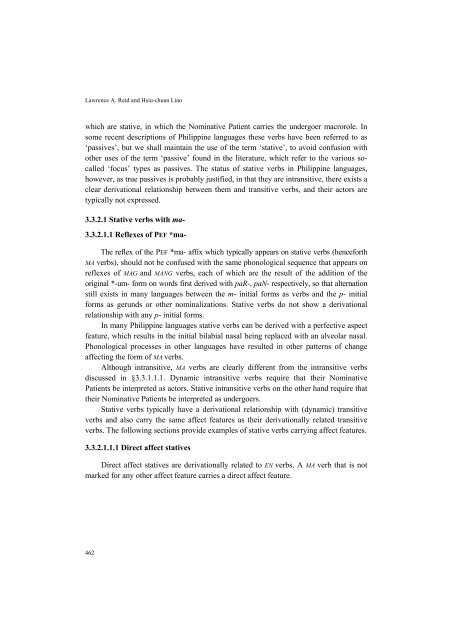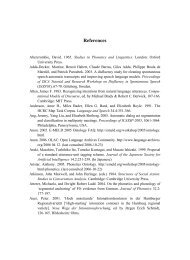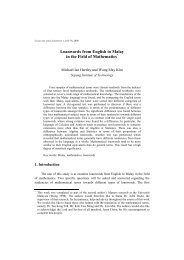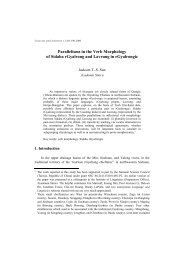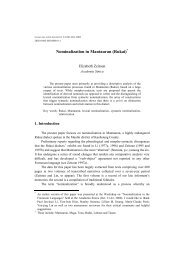A Brief Syntactic Typology of Philippine Languages - Academia Sinica
A Brief Syntactic Typology of Philippine Languages - Academia Sinica
A Brief Syntactic Typology of Philippine Languages - Academia Sinica
You also want an ePaper? Increase the reach of your titles
YUMPU automatically turns print PDFs into web optimized ePapers that Google loves.
Lawrence A. Reid and Hsiu-chuan Liao<br />
which are stative, in which the Nominative Patient carries the undergoer macrorole. In<br />
some recent descriptions <strong>of</strong> <strong>Philippine</strong> languages these verbs have been referred to as<br />
‘passives’, but we shall maintain the use <strong>of</strong> the term ‘stative’, to avoid confusion with<br />
other uses <strong>of</strong> the term ‘passive’ found in the literature, which refer to the various socalled<br />
‘focus’ types as passives. The status <strong>of</strong> stative verbs in <strong>Philippine</strong> languages,<br />
however, as true passives is probably justified, in that they are intransitive, there exists a<br />
clear derivational relationship between them and transitive verbs, and their actors are<br />
typically not expressed.<br />
3.3.2.1 Stative verbs with ma-<br />
3.3.2.1.1 Reflexes <strong>of</strong> PEF *ma-<br />
The reflex <strong>of</strong> the PEF *ma- affix which typically appears on stative verbs (henceforth<br />
MA verbs), should not be confused with the same phonological sequence that appears on<br />
reflexes <strong>of</strong> MAG and MANG verbs, each <strong>of</strong> which are the result <strong>of</strong> the addition <strong>of</strong> the<br />
original *-um- form on words first derived with paR-, paN- respectively, so that alternation<br />
still exists in many languages between the m- initial forms as verbs and the p- initial<br />
forms as gerunds or other nominalizations. Stative verbs do not show a derivational<br />
relationship with any p- initial forms.<br />
In many <strong>Philippine</strong> languages stative verbs can be derived with a perfective aspect<br />
feature, which results in the initial bilabial nasal being replaced with an alveolar nasal.<br />
Phonological processes in other languages have resulted in other patterns <strong>of</strong> change<br />
affecting the form <strong>of</strong> MA verbs.<br />
Although intransitive, MA verbs are clearly different from the intransitive verbs<br />
discussed in §3.3.1.1.1. Dynamic intransitive verbs require that their Nominative<br />
Patients be interpreted as actors. Stative intransitive verbs on the other hand require that<br />
their Nominative Patients be interpreted as undergoers.<br />
Stative verbs typically have a derivational relationship with (dynamic) transitive<br />
verbs and also carry the same affect features as their derivationally related transitive<br />
verbs. The following sections provide examples <strong>of</strong> stative verbs carrying affect features.<br />
3.3.2.1.1.1 Direct affect statives<br />
Direct affect statives are derivationally related to EN verbs. A MA verb that is not<br />
marked for any other affect feature carries a direct affect feature.<br />
462


